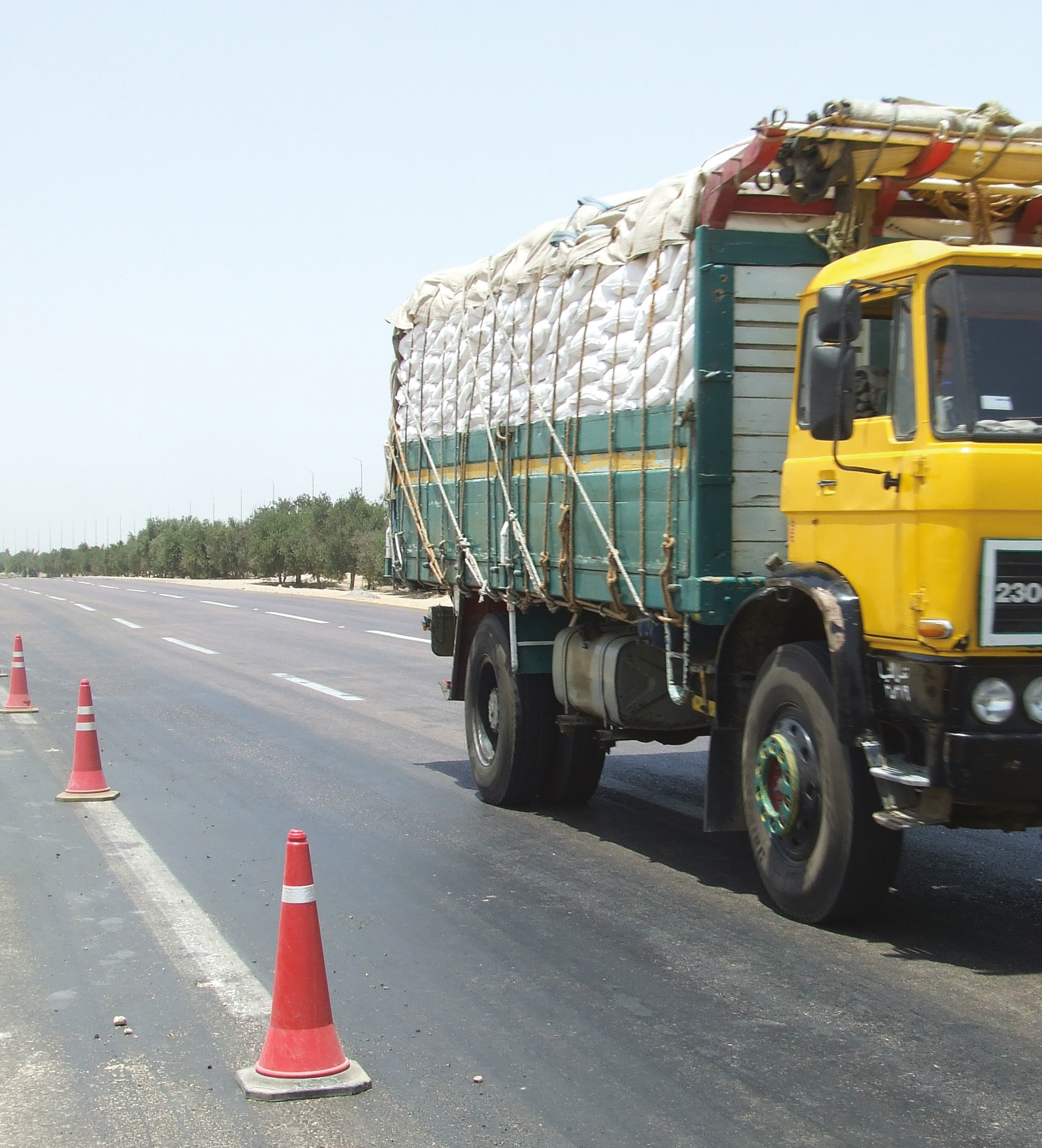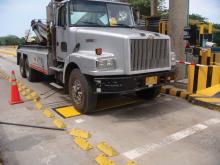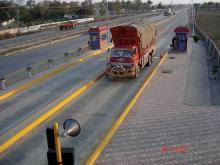The market and technology for weigh-in-motion systems continues to evolve – Mike Woof writes. for both mature and developing highway infrastructure networks, traffic densities play an important role in determining road wear and life. Monitoring traffic volumes and individual vehicle weight is crucial for ensuring roads can cope in the long term and that maintenance can be planned, while the problem of overloading can be eliminated.

Egypt’s rebuilt Cairo – Alexandria route will feature
sophisticated WIM technology
RSS
Overloading of heavy trucks places massive stresses on road structures and triggers rapid wear and early failure. Developed countries have long implemented systems to reduce the incidence of overloading and these technologies have become more sophisticated, more accurate and more efficient. Weigh-inmotion (WIM) systems reduce delays from truck weighing while providing the accurate measurement needed for enforcement. In developing countries, where funds for road maintenance and repair may be even more restricted, the need to prevent overloading is becoming more and more apparent. For those countries with highway tolling models, adding WIM technology offers an effective way to maximise efficiency.
In Egypt for example the mega highway currently under construction that will connect capital Cairo with the country’s main port Alexandria is being built as a toll road.
The main central highway features weight restrictions, with WIM technology being installed at the toll booths to monitor vehicle weight. Trucks using the highway are restricted to a maximum GVW, a system the Egyptian authorities are using to reduce road wear, extend life and lower the need for roadway maintenance. Trucks pay tolls that increase incrementally and in relation to the degree of overloading, with vehicles above a certain weight banned from the main highway and required to use the parallel service roads that run on either side.
AMG Systems is suppling its AMG 9000 managed ruggedised Ethernet switches for ITNL in India which is using the transmission equipment for the new 119km addition to Highway No 8. ITNL is implementing the road, connecting Beawar to Gomti in the State of Rajasthan, as a Build, Operate and Transfer (BOT) project on behalf of the Indian Government’s Ministry of Road Transport & Highways.
The highway features two toll plazas, each with six lanes, including one extra wide lane in each direction. The toll system has been developed in-house by ITNL and operates as a semi-automated collection system with automatic vehicle classification, slow speed weigh-in-motion and lane controllers installed at all the toll plazas. Additionally each lane has a camera for incident capturing.
The climate in Rajasthan is very hot with extreme temperatures, sandy and often dusty, so ITNL preferred to implement the highly ruggedised industrial Ethernet equipment from AMG Systems and this solution also provides redundancy in case of link failure. ITNL is using managed switches and currently there are two links between the control room and the lane, so if one link fails, it automatically switches to the redundant link.
The AMG 9000 solution is transmitting all the signals from the auxiliary equipment, CCTV cameras and DVRs. The solution also covers lane traffic lights and overhead lane signs There is a provision to connect both toll plaza control rooms to each other as well as to head office. The solution has further been designed to incorporate future expansion such as an increase in toll lanes and/or an IP based CCTV surveillance system.
Canadian firm International Road Dynamics (248 IRD) has built a strong reputation for its ability to integrate WIM systems with complementary products. IRD’s latest Intelligent Sensor Interface and Network Controller (iSINC) package supports a variety of WIM sensors, but can also control camera systems, message signs, and vehicle identification systems.
IRD offers the iSINC as the controller for its commercial vehicle enforcement and traffic data collection projects. Meanwhile iSINCLite is available as a standalone product for integrators seeking an off-the-shelf solution for complex WIM applications.
The company points out that its WIM Plus range offers environmental and fuel savings, as well as improved traffic flow to commercial vehicle operations. IRD's iSINC package allows WIM integration with camera systems, databases, signs, AVI, and non-intrusive sensors, making it suitable for use in numerous3278 ITS applications. This controller is used in IRD’s virtual and remote control weigh stations, data collection systems, and automated toll road systems. For data collection applications it can be configured to provide volume, occupancy and speed (VOS) data in real-time.
IRD says that its iSINC system is modular, which allows installations to be upgraded as traffic management strategies change. The VWS module provides a web browser user interface to the iSINC, making it easy to access WIM data over the internet. Meanwhile, IRD’s WIM@Toll can be linked with existing toll operations to provide accurate data so that users can be charged according to vehicle weight and class. The well-proven WIM@ Toll systems allow toll operators to screen for overweight trucks without interrupting traffic flow at their operations. iSINC electronics can be integrated into any toll system using WIM sensors including: IRD-PAT bending plates, quartz sensors, DAW 50, and slow speed WIM scales.
The firm has had major success and has won some high profile deals. One of IRD’s biggest WIM contracts has come from the2364 US Department of Transportation, 2410 Federal Highway Administration (FHWA). Under this contract, IRD will be issued task orders to provide maintenance, download data, and perform verification checks at existing Long- Term Pavement Performance (LTPP) Specific Pavement Study (SPS) WIM sites located across the United States and Canada. The contract is a task-order based, indefinite-delivery-indefinitequantity agreement covering a forty-eight month period. The potential value of the project is approximately US$4.7 million.
WIM sites maintained under this agreement provide high accuracy traffic and load data.
Additionally, IRD camera systems will be deployed at select WIM locations which will cross-link vehicle images to corresponding vehicle records and enhance overall data collection. The LTPP programme aims to understand how pavements perform in order to provide data and products that will extend life at a reasonable cost. Given the interest in analysing the pavement performance data collected at the SPS sites, the FHWA established a national pooled study to increase the quality of traffic data to support analysis projects.
The FHWA Office of Infrastructure Research and Development administers the US LTPP programme in cooperation with the3510 American Association of State Highway and Transportation Officials (AASHTO), the National Academy of Science, and State Highway Agencies.
In addition, IRD won major contracts from the2855 Indiana Department of Transportation (INDOT) and the 1431 New York State Department of Transportation (NYSDOT). The Indiana agreement was for WIM and virtual weighin- motion (VWIM) systems, maintenance and repair. IRD is delivering, installing, commissioning, calibrating, and supporting WIM and VWIM equipment at numerous locations across Indiana.
Each site comprises a sensor array specified by INDOT as appropriate for the type of traffic data to be collected at that location.
VWIM systems also offer web access and image capture capabilities and, according to IRD, these provide powerful real time tools for commercial vehicle weigh screening. The company, which will work closely with the State as system enhancements and upgrades occur, says the systems supplied under this contract will provide high accuracy traffic and load data to the State for planning and roadway design purposes.
The two New York traffic monitoring system contracts are for installing, upgrading, repairing, operating and maintaining the NYSDOT data collection sites, with three optional one year extensions for a potential total duration of five years. There are four types of traffic data collection sites covered by the contract, including continuous count, automatic vehicle classification (AVC), weigh-in-motion (WIM), and permanent short count. The scope is to provide overall repair and maintenance services for these existing sites, as well as the installation of new sites to enhance the NYSDOT data collection programme.
NYSDOT collects, summarises, and interprets information about traffic travelling on the state’s highway system to assess transportation needs and highway infrastructure performance, as well as to develop highway planning and programming recommendations.
Traffic data is also important for route planning and the design of highway projects.
Meanwhile3301 Mettler Toledo reports success with its VWIM installation on US92 just outside Tampa, Florida. This system checks for gross overweight, axle weight and bridge formula violations. In addition to weight, the system captures a digital overview photo of the vehicle, checks for overheight and includes a license plate reader (LPR) with optical character recognition (OCR). The data (plate number and jurisdiction) is used to search for database violations, which can identify stolen vehicles, expired permits, safety and other commercial vehicle issues.
Information recorded by the VWIM is bundled together as a vehicle record which includes WIM data, images and LPR. This is immediately accessible on a web server by law enforcement personnel who may be patrolling in the area. Using a wireless internet connection law enforcement officers have immediate access to vehicle records from patrol cars, easing the apprehension of violators.
RSS
The market and technology for weigh-in-motion systems continues to evolve – Mike Woof writes
for both mature and developing highway infrastructure networks, traffic densities play an important role in determining road wear and life. Monitoring traffic volumes and individual vehicle weight is crucial for ensuring roads can cope in the long term and that maintenance can be planned, while the problem of overloading can be eliminated.Overloading of heavy trucks places massive stresses on road structures and triggers rapid wear and early failure. Developed countries have long implemented systems to reduce the incidence of overloading and these technologies have become more sophisticated, more accurate and more efficient. Weigh-inmotion (WIM) systems reduce delays from truck weighing while providing the accurate measurement needed for enforcement. In developing countries, where funds for road maintenance and repair may be even more restricted, the need to prevent overloading is becoming more and more apparent. For those countries with highway tolling models, adding WIM technology offers an effective way to maximise efficiency.
In Egypt for example the mega highway currently under construction that will connect capital Cairo with the country’s main port Alexandria is being built as a toll road.
The main central highway features weight restrictions, with WIM technology being installed at the toll booths to monitor vehicle weight. Trucks using the highway are restricted to a maximum GVW, a system the Egyptian authorities are using to reduce road wear, extend life and lower the need for roadway maintenance. Trucks pay tolls that increase incrementally and in relation to the degree of overloading, with vehicles above a certain weight banned from the main highway and required to use the parallel service roads that run on either side.
AMG Systems is suppling its AMG 9000 managed ruggedised Ethernet switches for ITNL in India which is using the transmission equipment for the new 119km addition to Highway No 8. ITNL is implementing the road, connecting Beawar to Gomti in the State of Rajasthan, as a Build, Operate and Transfer (BOT) project on behalf of the Indian Government’s Ministry of Road Transport & Highways.
The highway features two toll plazas, each with six lanes, including one extra wide lane in each direction. The toll system has been developed in-house by ITNL and operates as a semi-automated collection system with automatic vehicle classification, slow speed weigh-in-motion and lane controllers installed at all the toll plazas. Additionally each lane has a camera for incident capturing.
The climate in Rajasthan is very hot with extreme temperatures, sandy and often dusty, so ITNL preferred to implement the highly ruggedised industrial Ethernet equipment from AMG Systems and this solution also provides redundancy in case of link failure. ITNL is using managed switches and currently there are two links between the control room and the lane, so if one link fails, it automatically switches to the redundant link.
The AMG 9000 solution is transmitting all the signals from the auxiliary equipment, CCTV cameras and DVRs. The solution also covers lane traffic lights and overhead lane signs There is a provision to connect both toll plaza control rooms to each other as well as to head office. The solution has further been designed to incorporate future expansion such as an increase in toll lanes and/or an IP based CCTV surveillance system.
Canadian firm International Road Dynamics (
IRD offers the iSINC as the controller for its commercial vehicle enforcement and traffic data collection projects. Meanwhile iSINCLite is available as a standalone product for integrators seeking an off-the-shelf solution for complex WIM applications.
The company points out that its WIM Plus range offers environmental and fuel savings, as well as improved traffic flow to commercial vehicle operations. IRD's iSINC package allows WIM integration with camera systems, databases, signs, AVI, and non-intrusive sensors, making it suitable for use in numerous
IRD says that its iSINC system is modular, which allows installations to be upgraded as traffic management strategies change. The VWS module provides a web browser user interface to the iSINC, making it easy to access WIM data over the internet. Meanwhile, IRD’s WIM@Toll can be linked with existing toll operations to provide accurate data so that users can be charged according to vehicle weight and class. The well-proven WIM@ Toll systems allow toll operators to screen for overweight trucks without interrupting traffic flow at their operations. iSINC electronics can be integrated into any toll system using WIM sensors including: IRD-PAT bending plates, quartz sensors, DAW 50, and slow speed WIM scales.
The firm has had major success and has won some high profile deals. One of IRD’s biggest WIM contracts has come from the
WIM sites maintained under this agreement provide high accuracy traffic and load data.
Additionally, IRD camera systems will be deployed at select WIM locations which will cross-link vehicle images to corresponding vehicle records and enhance overall data collection. The LTPP programme aims to understand how pavements perform in order to provide data and products that will extend life at a reasonable cost. Given the interest in analysing the pavement performance data collected at the SPS sites, the FHWA established a national pooled study to increase the quality of traffic data to support analysis projects.
The FHWA Office of Infrastructure Research and Development administers the US LTPP programme in cooperation with the
In addition, IRD won major contracts from the
Each site comprises a sensor array specified by INDOT as appropriate for the type of traffic data to be collected at that location.
VWIM systems also offer web access and image capture capabilities and, according to IRD, these provide powerful real time tools for commercial vehicle weigh screening. The company, which will work closely with the State as system enhancements and upgrades occur, says the systems supplied under this contract will provide high accuracy traffic and load data to the State for planning and roadway design purposes.
The two New York traffic monitoring system contracts are for installing, upgrading, repairing, operating and maintaining the NYSDOT data collection sites, with three optional one year extensions for a potential total duration of five years. There are four types of traffic data collection sites covered by the contract, including continuous count, automatic vehicle classification (AVC), weigh-in-motion (WIM), and permanent short count. The scope is to provide overall repair and maintenance services for these existing sites, as well as the installation of new sites to enhance the NYSDOT data collection programme.
NYSDOT collects, summarises, and interprets information about traffic travelling on the state’s highway system to assess transportation needs and highway infrastructure performance, as well as to develop highway planning and programming recommendations.
Traffic data is also important for route planning and the design of highway projects.
Meanwhile
Information recorded by the VWIM is bundled together as a vehicle record which includes WIM data, images and LPR. This is immediately accessible on a web server by law enforcement personnel who may be patrolling in the area. Using a wireless internet connection law enforcement officers have immediate access to vehicle records from patrol cars, easing the apprehension of violators.
RSS









